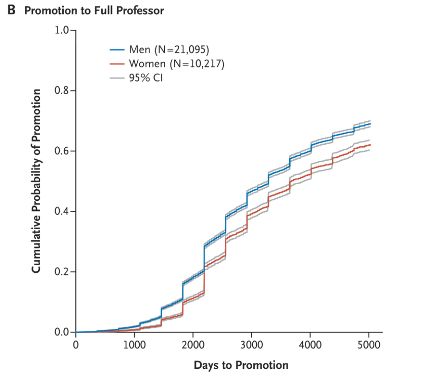
A privilege to write this article in @Clin_Trials with @CRWUSOM Dean Emerita Dr. Pamela Davis appliedclinicaltrialsonline.com/view/pandemic-…
A 🧵 on why gender equity in clinical research matters #WomenInMedicine 1/n
A 🧵 on why gender equity in clinical research matters #WomenInMedicine 1/n
@Clin_Trials The #COVID19 pandemic has had a disproportionate impact on women physicians and researchers, exacerbating long-standing issues of gender inequality in medicine gender.stanford.edu/news-publicati… 2/n
@Clin_Trials Among physician researchers, women spend 8.5 hours more per week on domestic activities. Not surprisingly women were more impacted by the abrupt closure of schools and child care facilities brought on by the pandemic acpjournals.org/doi/10.7326/M1… 3/n 

@Clin_Trials The disparities in academic productivity quickly became evident in publications submitted by women vs men since the start of the pandemic:
📝 COVID-19 elifesciences.org/articles/58807
📝 Cardiology ahajournals.org/doi/10.1161/JA…
📝 The Lancet thelancet.com/journals/lance… 4/n
📝 COVID-19 elifesciences.org/articles/58807
📝 Cardiology ahajournals.org/doi/10.1161/JA…
📝 The Lancet thelancet.com/journals/lance… 4/n
@Clin_Trials The disproportionate impact of the pandemic on women faculty is superimposed upon long-standing gender disparities in medicine. Women make up 48% of medical school graduates but only 25% of full professors and 18% of department chairs aamc.org/data-reports/d… 5/n 

@Clin_Trials There is a gender pay gap among physician researchers that persists even after adjusting for differences in specialty, institutional characteristics, academic productivity, academic rank, and work hours jamanetwork.com/journals/jama/… 6/n
@Clin_Trials Career recognition is critical for promotion, but women are underrepresented among:
🎤 Grand rounds speakers jamanetwork.com/journals/jamai…
🎤 Conference speakers jamanetwork.com/journals/jaman…
🏆 Society awardees onlinelibrary.wiley.com/doi/full/10.10… 7/n
🎤 Grand rounds speakers jamanetwork.com/journals/jamai…
🎤 Conference speakers jamanetwork.com/journals/jaman…
🏆 Society awardees onlinelibrary.wiley.com/doi/full/10.10… 7/n
@Clin_Trials Women are less likely to be promoted to full professors even after adjusting for age, years since training, specialty, and measures of research productivity jamanetwork.com/journals/jama/… 8/n
@Clin_Trials Even more frustrating, there has been no narrowing in the promotions gap over 35 years nejm.org/doi/full/10.10… 9/n 



@Clin_Trials In addition, women face more frequent sexual harassment. Among recipients of K08 and K23 career development awards, 66% of women (vs 10% of men) report experiencing gender bias, and 30% of women (vs 4% of men) report experiencing sexual harassment jamanetwork.com/journals/jama/… 10/n
@Clin_Trials Within six years of completing clinical training, 22.6% of women physicians are no longer working full-time, compared with 3.6% of male physicians. This gap becomes even more pronounced (30.6% of women vs 4.6% of men) among physicians with children jamanetwork.com/journals/jaman… 11/n
@Clin_Trials Attrition of women physicians directly impacts patient care because studies suggest women physicians may have better clinical outcomes. Female primary care physicians spend more time with patients nejm.org/doi/full/10.10… 12/n
@Clin_Trials Patients undergoing coronary artery bypass grafting had shorter hospital length of stay when treated by an all-female physician team as compared with an all-male team bmjopen.bmj.com/content/11/8/e… 13/n
@Clin_Trials Clinical trials are crucial fbringing new medications and interventions to patients, yet women have often been excluded as participants. The inclusion of women in clinical research did not become law until the NIH Revitalization Act of 1993 orwh.od.nih.gov/toolkit/recrui… 14/n
@Clin_Trials In a study of RCTs of heart failure, females were under-enrolled in 72% of trials. Under-enrollment of females was associated with men in first or last authorship position onlinelibrary.wiley.com/doi/10.1002/ej… 15/n
@Clin_Trials Given the importance of including women as participants in clinical trials, women should be well represented among clinical investigators. But women comprise only approximately 10% of leaders and authors of major cardiovascular clinical trials jamanetwork.com/journals/jamai… 16/n
@Clin_Trials Last year @CRForumUS convened a committee to address the impact of the COVID-19 pandemic on women in clinical research. We and colleagues prepared a framework for action, recently published in @NatureMedicine nature.com/articles/s4159… 17/n
@Clin_Trials @CRForumUS @NatureMedicine We must act now, otherwise the benefits for clinical research that come with gender equity in medicine will only become even more difficult to achieve 18/End 

• • •
Missing some Tweet in this thread? You can try to
force a refresh





